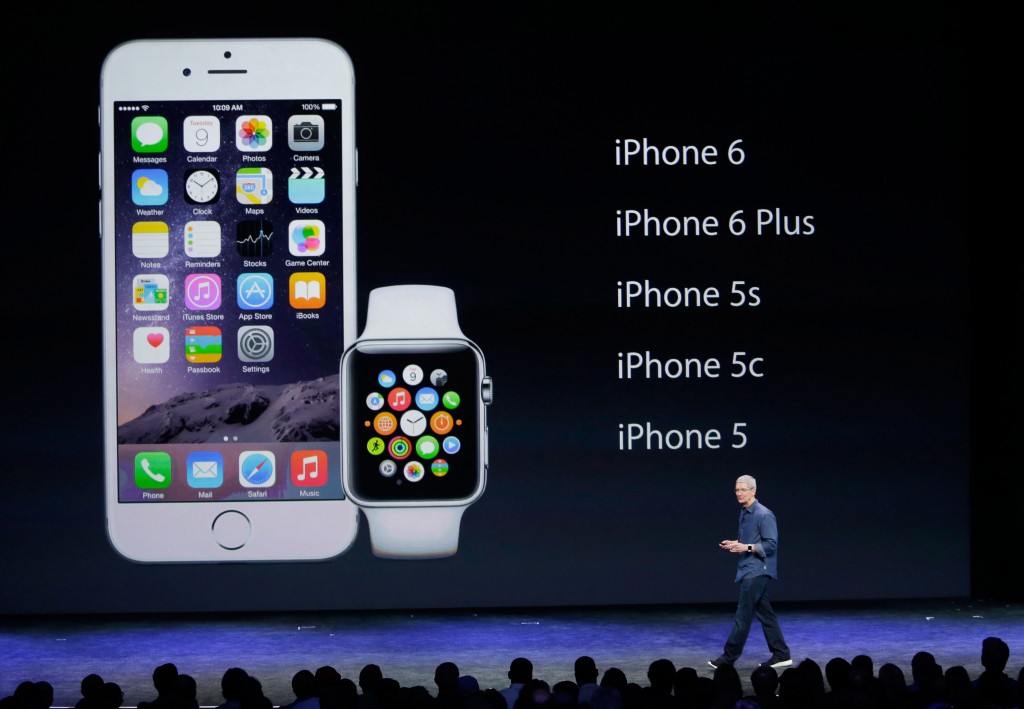
In keeping with its fall tradition, Apple announced Tuesday its next in a line of mobile devices: the iPhone 6, the anticipated iPhone 6 Plus and, finally, the Apple Watch (surprisingly not called the iWatch).
Apart from hardware, Apple also announced the latest edition of its mobile operating system, iOS 8, as well as new services like its mobile payment system, Apple Pay. While Apple has shown up every year with new stuff, this is the first time since the iPhone 4 that the new Apple lineup feels like true innovation, not just iteration. In light of decisions being made by competitors like Samsung, Apple is ensuring that its products not only stay relevant, but continue to challenge the way people see mobile communication.
Until now, the iPhone has been slow to adapt to demands for larger screen sizes. While competitors manufacturing for Android OS have created a subculture around “phablets” (a phone-tablet hybrid), Apple had been sitting quietly. As it turned out, phablets weren’t just a fad, and larger phones became standard as phone developers shifted away from compact designs. Until the release of the iPhone 5 two years ago, which comes with a 4-inch screen, iPhone users were limited to the 3.5-inch screen on the still-popular iPhone 4S and its predecessor, the iPhone 4. Meanwhile, Android users have been enjoying 4.7-inch and even 5.3-inch screens on comparable Samsung and Motorola models. Finally, Apple has released the iPhone 6, which sports a 4.7-inch screen, as well as the iPhone 6 Plus, which carries a 5.5-inch screen.
The design of the new iPhone is thinner and larger than ever before, abandoning the flat sides and returning to the curved edges found on most mainstream smartphones, while retaining the iPhone’s trademark glass display and aluminum body. Apple disappointed many with the omission of the scratch resistant and more touch-sensitive Sapphire glass in its displays. The glass currently covers only the iPhones’ optical lens. The pixel-density is really high, though, with 1 million pixels on the iPhone 6 and 2 million pixels on the iPhone 6 Plus. The overall battery life has also improved despite larger displays. The iPhone 6 can last 14 hours of talk time, and the iPhone 6 Plus can last a whopping 24 hours of talk time (up from the iPhone 5S’s 10 hours).
Another enhancement involves the iPhones’ cameras. While still eight megapixels, they now have several new and improved features, including optical image stabilization in the iPhone 6 Plus, to ensure your pictures are clearer and more colorful than ever before.
While most people just want the new iPhone, Apple has finally entered into the market of wearable technology with its Apple Watch.
The Apple Watch isn’t just a step up from a Casio; it’s a completely new way to use technology in your life. As a first-generational device from Apple, we can expect that they are treading lightly into this new category of technology, much like the first iPad. That being said, it’s not the must-have item of the fall, and at a hefty minimum price tag of $350, it’s clear that this isn’t the accessory for everyone.
The issue with smart watches so far is that it’s unclear as to what problem they’re providing a solution for. While the Apple Watch seeks to offer new means of communication between watch users (tap communication, walkie-talkie sound bits, etc.), it’s very speculative whether these methods will enter mainstream culture. As of now, wearables are usually used for fitness, and the Apple Watch communicates fitness data between the watch and the iPhone. While it might be a neat tool to use in conjunction with your iPhone, it still just seems like an expensive convenience.
Apple Watch will integrate Apple Pay. With Apple Pay, you can securely enter your Visa, MasterCard or American Express credit card information and use these cards on the go with the assistance of your iPhone or Apple Watch. The new service, projected to launch in October, will also let you register debit cards from select banks. Using shortwave communications, the devices will be able to connect with payment devices like tap-to-pay credit card scanners, and will require a fingerprint scan to use. Currently, over 220,000 stores accept Apple Pay methods.
This year, Apple revealed devices that seem to be more useful and professional in nature. With the Apple Watch bringing the latest updates to your wrist, and the iPhone carrying more screen space and battery life than ever before, it’s safe to say Apple is finally inventing again. The Apple Watch is projected for release in early 2015, with the iPhone 6 and iPhone 6 Plus available for pre-order now, with phones shipping out Sept. 19.


